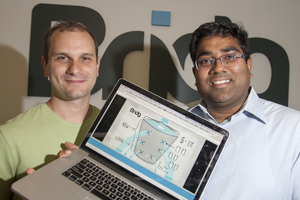Go out to eat and chances are a server will at some point ask if you are enjoying your meal. But Amit Jain believes that’s an unnecessary question, as the answer is already there, hidden in your payment data.
Jain is founder and chief executive of Bridg, a West L.A. company that uses data restaurants already collect to predict customer behavior – and, more importantly, to stock the items diners really crave.
Bridg serves a multitude of brick-and-mortar businesses, from furniture stores to big-box retailers, but it has found a particular niche with restaurants, which have to constantly update their menus to stay ahead of the dynamic American palate. (Ten years ago, who cared about kale and Greek yogurt?)
The company combines sales data with information from credit card swipes, then analyzes it all to provide useful insights. For instance, which items are popular among the most loyal customers? Which items have diners heading for the door?
Restaurant owners have historically relied purely on sales numbers for this type of intelligence. But Jain said that gives owners an incomplete picture.
“Sales just track how well it’s written on the menu,” he said. “Bridg can track whether someone ordering this item ever came back.”
Know thy customer
Jain, a former Google Inc. adviser and co-founder of coupon website Savings.com, said Bridg was inspired by the effectiveness with which online retailers such as Seattle’s Amazon.com can predict what customers will order next and suggest items they’re likely to seriously consider.
“What we’ve done is build a tech platform to bring the power of customer knowledge that Amazon has leveraged for years to brick-and-mortar businesses,” Jain said. “How you run the business has changed from sales to tracking customer behavior. That’s how Amazon runs, but that’s not how Panera was run until a couple years ago.”
Indeed, most restaurant owners are focused on sales. Items that sell well are good; items that sell poorly are not. But Jain said simple sales data is a lot less relevant in predicting which items will be hits or flops than digging into the spending habits of individual diners.
“The first thing we have done for many of these companies is change their view from looking at how many they sold last week to what their customers did last week,” Jain said. “How many customers walked in? How many came back? What did they buy when they returned? That knowledge never existed.”
Restaurants have had access to payment data for as long as they’ve been accepting credit cards, but Jain said Bridg connects that data to sales information, helping restaurant owners offer items their customers really want.
For example, a restaurant might introduce a special item that sells well initially, but six months down the line, overall business slows down. Bridg might show that diners who had been regulars tried the new item but were so disappointed that they decided not to return. While he wouldn’t name the customer, Jain said something like the above scenario recently happened, where Bridg’s analytics convinced a restaurant to take a dud item off the menu before it could do more harm.
Conversely, Bridg might show that a light-selling dish is worth keeping on the menu because it’s a favorite of a handful of loyal customers. In either case, sales data alone wouldn’t be enough to show the restaurateur what’s really going on.
Meal team
Bridg, founded in 2012, works with national restaurant brands including Pizza Hut, a subsidiary of Louisville, Ky.’s Yum Brands Inc.; Denver sandwich shop Quiznos; and Panera Bread in Sunset Hills, Mo., as well as other smaller, regional chains. Jain declined to disclose revenue and said Bridg is not yet profitable.
The company, which has about 30 employees, has raised around $10 million from investors including Brentwood’s Karlin Ventures, and Santa Monica firms March Capital and Canyon Creek Capital. The executive team includes Chief Operating Officer Gilles Marchand and Chief Technology Officer Jared Cugno.
Bridg initially acquired customers almost exclusively by word of mouth, but over the past year, Jain has filled out a three-person sales team and the company has started hosting mixers for restaurant industry executives. But customer testimonials are still the company’s most important advertising tool.
Another selling point has been Bridg’s ability to quickly figure out what new items are working. Restaurants commonly offer a product for a limited time to see if it gains any traction, and Bridg can give them an answer quickly.
“When they try these products, it takes them about seven to nine months to figure out whether it will work,” Jain said. “Bridg is able to discern that within a week.”
Kevin Burke, managing partner of West L.A. restaurant industry investment bank Trinity Capital, said Bridg will be most effective with establishments that already capture good data, both from card payments and other avenues such as loyalty programs.
“The way to make a standout experience – which gets people coming back – is to know exactly what they want,” Burke said. “Predictive analytics really start making sense if you can tie together all the info you can glean from credit card data, social media, loyalty programs and other forms of feedback.”
Bridg isn’t the only data game in town. Burke said Taco Bell has its own number-crunching methodology, which includes payment data, social media analytics and even feedback from mystery shoppers – randomly selected diners who rate items in exchange for a code they can redeem for free food or drink.
Burke said the chain’s focus on data has been a huge factor in helping it master its niche, something Bridg wants to do for its customers.
“Taco Bell knows exactly who their customers are, and they can figure out what they want and how they want it,” he said.

